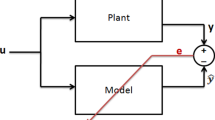Abstract
In this study, the linguistic information feed-back-based dynamical fuzzy system (LIFBDFS) proposed earlier by the authors is first introduced. The principles of α-level sets and backpropagation through time approach are also briefly discussed. We next employ these two methods to derive an explicit learning algorithm for the feedback parameters of the LIFBDFS. With this training algorithm, our LIFBDFS indeed becomes a potential candidate in solving real-time modeling and prediction problems.







Similar content being viewed by others
References
Kosko B (1997) Fuzzy engineering. Prentice-Hall, Upper Saddle River
Zhang J, Morris AJ (1999) Recurrent neuro-fuzzy networks for nonlinear process modeling. IEEE Trans Neural Netw 10(2):313–326
Zhang J (2005) Modeling and optimal control of batch processes using recurrent neuro-fuzzy networks. IEEE Trans Fuzzy Syst 13(4):417–427
Vlcek Z (2004) Analysis of autoregressive fuzzy systems. In: Proceedings of the IEEE international conference on fuzzy systems, Budapest, Hungary, pp 1233–1238
Liu H, Wang X, Zhang W, Xu G (2002) Market clearing price forecasting based on dynamic fuzzy system. In: Proceedings of the international conference on power system technology, Kunming, China, pp 890–896
Gao XZ, Ovaska SJ (2003) Dynamical fuzzy systems with linguistic information feedback. In: Melo-Pinto P, Teodorescu H-N, Fukuda T (eds) Systematic organization of information in fuzzy systems. IOS Press, Amsterdam, The Netherlands, pp 179–195
Gao XZ, Ovaska SJ, Wang X (2007) Linguistic information in dynamical fuzzy systems. In: 12th online world conference on soft computing in industrial applications
Gao XZ, Ovaska SJ, Wang X (2005) A simplified linguistic information feedback-based dynamical fuzzy system with learning algorithm—theory and evaluation. In: Proceedings of IEEE mid-summer workshop on soft computing in industrial applications, Espoo, Finland, pp 44–56
Gao XZ, Ovaska SJ (2006) Linguistic information feed-forward-based dynamical fuzzy systems. IEEE Trans Syst Man Cybern Part C 36(4):453–463
Martikainen J, Ovaska SJ (2005) Optimizing dynamical fuzzy systems using aging evolution strategies. In: Proceedings of the 9th IASTED international conference on artificial intelligence and soft computing, Benidorm, Spain, pp 5–10
Werbos PJ (1990) Backpropagation through time: What it does and how to do it. Proc IEEE 78(10):1550–1560
Ahmad AM, Ismail S, Samaon DF (2004) Recurrent neural network with backpropagation through time for speech recognition. In: Proceedings of the IEEE international symposium on communications and information technology, Sapporo, Japan, pp 98–102
Jang J-SR, Sun C-T, Mizutani E (1997) Neuro-fuzzy and soft computing: a computational approach to learning and machine intelligence. Prentice-Hall, Upper Saddle River
Tang KS, Man KF, Kwong S, He Q (1996) Genetic algorithms and their applications. IEEE Signal Process 13(6):22–37
Lin C-T, Lu Y-C (1995) A neural fuzzy system with linguistic teaching signals. IEEE Trans Fuzzy Syst 3(2):169–188
Uehara K, Fujise M (1993) Fuzzy inference based on families of α-level sets. IEEE Trans Fuzzy Syst 1(2):111–124
De Jesús O, Hagan MT (2007) Backpropagation algorithms for a broad class of dynamic networks. IEEE Trans Neural Netw 18(1):14–27
Pearlmutter BA (1995) Gradient calculations for dynamic recurrent neural networks: a survey. IEEE Trans Neural Netw 6(5):1212–1228
Acknowledgments
This research work was funded by the Academy of Finland under Grant 201353. The authors would like to thank the anonymous reviewers for their insightful comments and constructive suggestions that have improved the paper.
Author information
Authors and Affiliations
Corresponding author
Rights and permissions
About this article
Cite this article
Gao, X.Z., Ovaska, S.J. & Wang, X. A linguistic information feed-back-based dynamical fuzzy system (LIFBDFS) with learning algorithm. Neural Comput & Applic 18, 321–329 (2009). https://doi.org/10.1007/s00521-008-0183-5
Received:
Accepted:
Published:
Issue Date:
DOI: https://doi.org/10.1007/s00521-008-0183-5




